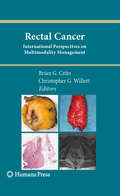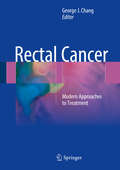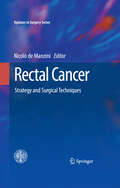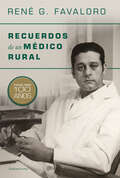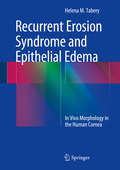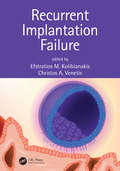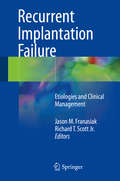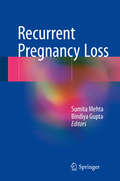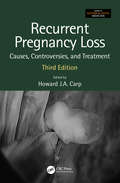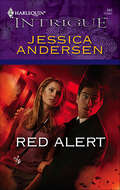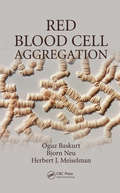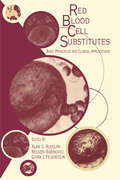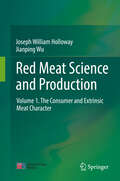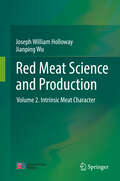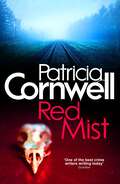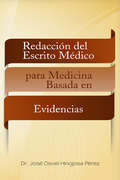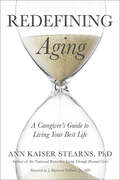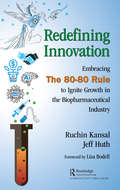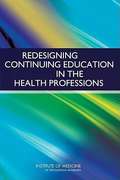- Table View
- List View
Rectal Cancer
by Christopher G. Willett Brian G. CzitoThis cutting-edge book delivers state of the art information on the evaluation and management of rectal cancer. Covering the spectrum of clinical management information from initial evaluation and staging, to advances and controversies in management, to survivor outcomes, sphincter preservation and quality of life, it is a comprehensive resource for this rapidly changing field. Surgery, radiation therapy, and chemotherapy, radiology, endoscopy, and pathology are fully explored, including the use of both novel and contemporary approaches in each of these disciplines. With examination of clinical trials in the United States and Europe, this book features the unique insights of a cadre of world renowned specialists. Rectal Cancer: International Perspectives on Multimodality Management is an engaging discussion of current and future directions. This book is necessary reading for medical, surgical, and radiation oncologists as well as pathologists, radiologists, and gastroenterologists treating primary and metastatic rectal cancer.
Rectal Cancer
by George J. ChangRectal Cancer: Modern Approaches to Treatment provides a useful overview of the multidisciplinary treatment of rectal cancer with a deeper dive into clinical challenges faced by treating physicians. Written by the leading experts in the field, it provides a practical management guide with an emphasis on the state-of-the-art that will be of value to both novices and experts engaged in rectal cancer treatment.
Rectal Cancer
by Nicolò De ManziniThis book gives an updated and detailed overview of diagnostic and therapeutic strategies for rectal cancer. Rectal cancer has become an increasing and serious disease in western countries, mainly linked to lifestyle and bad alimentation habits. This specific cancer is not only a threat to the lifespan of patients, but also has a heavy impact on quality of life, due to its implications in the fecal, urinary and sexual functions. Recent guidelines of prevention and early diagnosis, as well as current and future diagnostic and staging work-up, are here presented in a clear and convincing way, linking each topic to the therapeutic options arising from the staging and including a chapter on the molecular evaluation of the tumor. To complete the multifaceted approach to this particular pathology, a large part is devoted to the in-hospital care of rectal cancer patients, beginning from the fast-track procedures and the enhanced recovery systems, up to the in-depth description of the available of surgical techniques, including salvage situations, accidents, complications, and their treatment. A final chapter will be dedicated to the follow-up policy and its advantages.
Recuerdos de un médico rural: Favaloro 100 años
by Rene FavaloroNueva edición por el 100 aniversario del nacimiento del Dr. Favaloro. Uno de los médicos más reconocidos del país rememora sus experiencias como médico en un pueblo del oeste pampeano y reflexiona sobre las condiciones en las que se ejerce su profesión en la Argentina. Entre comienzos de la década del 50 y 1962, René Favaloro se desempeñó como médico rural en el pueblo pampeano de Jacinto Aráuz. Estos doce años fueron los que lo definieron, tanto en su vida profesional como en la personal. El mismo doctor que se volverá una eminencia años después en Cleveland, trabajando con los profesionales más destacados de la medicina internacional, inició su carrera en el interior de la Argentina, y fue esa labor lo que más marcó su vocación. En 1980 publicó esta obra, su primer libro autobiográfico. En él reflexionó acerca de su propia experiencia y del ejercicio de la medicina en algunas zonas postergadas del país, a la vez que advirtió sobre el devenir de la práctica pública de la salud y cierta decadencia en la formación de nuevos médicos. Recuerdos de un médico rural tuvo un gran recibimiento. "Mi objetivo -decía en el prólogo a la segunda edición, que escribió emocionado por las cartas que le habían enviado cole - gas y maestros rurales que se sintieron representados en sus escritos- no es presentar la simple descripción de hechos anecdóticos sino, a través de ellos, mostrar las condiciones socioeconómicas del interior". Y se preguntaba: "¿Tendremos capacidad de reaccionar? ¿Seremos capaces de realizar la verdadera reconstrucción?".
Recurrent Erosion Syndrome and Epithelial Edema
by Helena M. TaberyThis book presents high-magnification in vivo images of the morphology of recurrent corneal erosions and epithelial edema as captured by non-contact photomicrography. Part I of the book, on recurrent erosion syndrome, displays images covering a broad spectrum of epithelial changes, including manifestations of the ongoing underlying pathological process and epithelial activity aimed at elimination of abnormal elements or repair. The dynamics of the interplay between these opposing forces are captured in sequential photographs that aid interpretation. Part II of the book demonstrates typical features of corneal epithelial edema and also covers the contemporaneous occurrence, and dynamics, of phenomena indistinguishable from those commonly seen in recurrent erosion syndrome. Both parts include case reports illustrating typical features and documenting variability in symptoms and findings over time. The presented morphology will facilitate understanding of clinical appearances and assist in differential diagnosis.
Recurrent Implantation Failure
by Efstratios M. Kolibianakis and Christos A. VenetisImplantation is a complex phenomenon, still not thoroughly understood, involving the embryo and the endometrium. Successful implantation is considered to stem from an efficient combination of various embryo and/or maternal factors. Repeated failure of any of these factors or of their combination might decrease the chance of implantation and eventually lead to recurrent implantation failure. Despite technological advances, only about a quarter of In Vitro Fertilization procedures will result in live birth, leading many couples to experience multiple failures. This text from international experts explores the various factors at play and offers a helpful summary of the state of knowledge to help guide clinicians in their management of this complex and important problem. Contents: What is Recurrent Implantation Failure? * The psychosocial aspects of recurrent implantation failure * The role of life-style factors in RIF * Endocrine causes of recurrent implantation failure * Congenital uterine anomalies and recurrent implantation failure * Immunological causes of recurrent implantation failure * Acquired uterine conditions, reproductive surgery, and RIF? * Thrombophilia: diagnosis and management in women with recurrent implantation failure * Andrological causes of RIF * Diagnostic evaluation of RIF? (Modalities and algorithm) * Optimizing embryo culture for RIF? * Optimizing endometrial receptivity for patients with recurrent implantation failure: The role of progesterone on the day of triggering final oocyte maturation * Is there a role of follicular phase LH and E2 on the day of triggering final oocyte maturation for embryo implantation? * Manipulating the endometrium: Can RIF be managed by inducing endometrial inflammation or by the use of novel research therapies * The embryo in RIF: Genetic selection and strategies for improving its implantation potential * Is oocyte donation efficient in patients with RIF? * Sperm donation and RIF? * Optimizing embryo transfer technique for RIF management * Proposed management of patients with recurrent implantation failure and directions for future research * When should patients abandon treatment?
Recurrent Implantation Failure: Etiologies And Clinical Management
by Jason M. Franasiak Richard T. Scott Jr.This unique text discusses the wide range of causes and pathophysiologic conditions contributing to recurrent implantation failure (RIF) and the current treatment approaches to best approach this challenging patient population. Beginning with a presentation of the mechanism of normal implantation, the physiologic synchrony between embryo and endometrium, and the roles of both gametes and embryos in RIF, the book then examines the various genetic, immune and environmental factors involved. Abnormalities of the hematologic and endocrine system, as well as those of the anatomy and microbiome, are described in detail. Last but no less important, the psychological stress and treatment of patients experiencing RIF is discussed. Assisted reproductive technology (ART) success has increased substantially over the past three decades. However, despite these advances, recurrent implantation failure is still a common issue confronting patients and clinicians, and RIF represents one of the greatest challenges in ART and remains a source of frustration and disappointment for patients, clinicians, and researchers involved in the process. Providing an in-depth investigation into the pathophysiology and biological mechanisms of RIF and its clinical management, this will be an excellent resource for reproductive endocrinologists and infertility specialists.
Recurrent Pregnancy Loss
by Sumita Mehta Bindiya GuptaThis book covers the entire topic of recurrent miscarriage extensively. Chapters cover demographics to recent and future management options. A special section on the role of controversial strategies has also been included. Lastly, the book features dedicated chapters on evidence-based approaches, which include step-by-step algorithms for the reader’s convenience.
Recurrent Pregnancy Loss
by Ole Bjarne ChristiansenRecurrent pregnancy loss is an emotional challenge for patients. This book offers a practical approach to office-based gynecologists and trainee gynecologists to learn how to identify the root causes and minimize the risks of further miscarriage in subsequent pregnancies. This book is part of the Gynecology in Practice Series, which aims to provide a clinical 'in the office' or 'at the bedside' guide to effective patient care for gynecologists.
Recurrent Pregnancy Loss and Adverse Natal Outcomes
by Minakshi RohillaRecurrent pregnancy loss (RPL) includes recurrent first- and second-trimester abortions and recurrent preterm delivery, second- or third-trimester intrauterine fetal death, intrapartum stillbirth, and early neonatal death. This book includes protocols for case scenarios of early and late pregnancy loss as well as instances of poor obstetric history. Key Features Explores the management of different clinical presentations of RPL Includes preeclampsia, intrahepatic cholestasis of pregnancy, and hypertension-related disorders in pregnancy Includes clinical protocols with flowcharts Features tip boxes with learning points for easy reference
Recurrent Pregnancy Loss: Causes, Controversies and Treatment
by Howard J.A. CarpMajor advances in genetics, immunology, and endocrinology have necessitated a new edition of this best-selling text. However, despite the advances, recurrent pregnancy loss presents a frustrating clinical problem. There is still disagreement about the number of pregnancy losses which warrant investigation and treatment and about which investigations should be performed. This third edition provides an authoritative and comprehensive update on advances in the understanding and management of this troubling phenomenon, covering both basic scientific topics such as genetics and cytokines, and profiles major advances in immunology, endocrinology, and thrombotic mechanism. Clinical research is discussed, as is assessment of results when applying an evidence-based approach or a more personalised approach, which is now becoming possible due to advances in the diagnosis of cause. There are lively debates on the role of progestogens and immunotherapy, which remain controversial. Designed for specialists working in reproductive medicine clinics and those involved with maternal-fetal care, the book is also ideal for generalists and gynecologists seeking a comprehensive view of developments in the field.
Recurrent Respiratory Papillomatosis
by Paolo CampisiThis volume provides a comprehensive review of recurrent respiratory papillomatosis and an up-to-date understanding of the etiology, pathophysiology, and management of these rare tumors caused by the human papillomavirus (HPV). The text covers the potential role of vaccines, its significant role in prevention and the controversy surrounding the use of them. Topics such as impact, quality of life, and patient advocacy are also covered and are vital to understanding the disease from the patient perspective. Recurrent Respiratory Papillomatosis will be an invaluable resource for practicing otolaryngologists, laryngologists, anesthesiologists, infectious disease specialists, and residents participating in the care of patients with this disease.
Red Alert
by Jessica AndersenPROTECTING HER BECAME HIS JOB...AND HIS OBSESSIONDr. Meg Corning detested the way Erik Falco stormed the halls of Boston General Hospital as if he owned the place. The fallen-cop-turned-ruthless-businessman was throwing his weight around in his bid to gain control of her breakthrough medical technology. But putting this sexy stranger in his place seemed impossible once he swooped to the rescue during a series of mysterious “accidents.” Before long, the explosive heat between them set off a chain reaction of pleasure and pain that nearly immobilized her. After Falco made a heart-stopping move to keep her safe, the data-obsessed doc knew it was time to analyze his true motives-and her own traitorous desires. Could they forge a bond of trust in time to outsmart a cold-blooded killer?
Red Blood Cell Aggregation
by Oguz Baskurt Björn Neu Herbert J. MeiselmanRed blood cells in humans-and most other mammals-have a tendency to form aggregates with a characteristic face-to-face morphology, similar to a stack of coins. Known as rouleaux, these aggregates are a normally occurring phenomenon and have a major impact on blood rheology. What is the underlying mechanism that produces this pattern? Does this real
Red Blood Cell Substitutes: Basic Principles and Clinical Applications: Basic Principles and Clinical Applications
by John R. Wilson Sarah SharplesPresents an up-to-date treatment of research strategies, clinical and commercial developments, and regulatory and economic issues pertaining to the formulation of effective and safe red blood cell substitutes. The text examines regulatory and socioeconomic aspects of blood substitute products, and global tranfusion practices from the perspective of
Red Meat Science and Production: Volume 1. The Consumer and Extrinsic Meat Character
by Joseph William Holloway Jianping WuThis book comprehensively describes the biological underpinnings of red meat production, discussing the current state of the science in the context of the provision of red meat products perceived by consumers to offer a quality eating experience. Covering advances in the science of red meat production, it focuses on production system elements that affect product quality. The chapters explore the latest developments in the determination of consumer preferences, and interpret of these preferences in terms of quality characteristics of red meat, investigating the science-based orchestration of red meat production to achieve product consistency. The book highlights topics such as consumer preferences, the biological and production system elements affecting red meat safety, and the intrinsic (appearance, aroma, and sensory quality) and extrinsic (humane animal and environmentally friendly production) characteristics of red meat. For each characteristic, it discusses the underlying biological and biochemical processes and examines means of altering production systems to impact consumer eating experiences. The book also features a perspective on creating holistic integrated systems for producing red meats to meet consumers’ expectations around the globe. Written by leading authorities in the area of global red meat production systems, it is a comprehensive resource for consumer-oriented red meat producers.
Red Meat Science and Production: Volume 2. Intrinsic Meat Character
by Joseph William Holloway Jianping WuThis book comprehensively describes the biological underpinnings of red meat production, discussing the current state of the science in the context of the provision of red meat products perceived by consumers to offer a quality eating experience. Covering advances in the science of red meat production, it focuses on production system elements that affect product quality. The chapters explore the latest developments in the determination of consumer preferences, and interpret of these preferences in terms of quality characteristics of red meat, investigating the science-based orchestration of red meat production to achieve product consistency. The book highlights topics such as consumer preferences, the biological and production system elements affecting red meat safety, and the intrinsic (appearance, aroma, and sensory quality) and extrinsic (humane animal and environmentally friendly production) characteristics of red meat. For each characteristic, it discusses the underlying biological and biochemical processes and examines means of altering production systems to impact consumer eating experiences. The book also features a perspective on creating holistic integrated systems for producing red meats to meet consumers’ expectations around the globe. Written by leading authorities in the area of global red meat production systems, it is a comprehensive resource for consumer-oriented red meat producers.
Red Mist (Kay Scarpetta #19)
by Patricia CornwellThe nineteenth book in the Kay Scarpetta series, from No. 1 bestselling author Patricia Cornwell.'America's most chilling writer of crime fiction' The TimesKay Scarpetta has arranged to meet an inmate at the high-security Georgia Prison for Women. The prisoner is a convicted sex offender and the mother of a vicious and diabolically brilliant killer.Against advice, Scarpetta is determined to hear this woman out - she believes she may hold some answers to the murder of her former deputy. But soon she finds connections to a string of grisly killings.As she learns more, Scarpetta is compelled to conclude that this is only the beginning of a terrifying terrain of conspiracy on an international scale. And she is the only one who can stop it . . .The next book in the Scarpetta series is The Bone Bed. And the brand-new instalment, Identity Unknown, is available now!DISCOVER THE SERIES THAT SHAPED THE WORLD OF CRIME FICTION'One of the best crime writers writing today' Guardian 'Devilishly clever' Sunday Times 'The top gun in this field' Daily Telegraph 'Forget the pretenders. Cornwell reigns' Mirror 'The Agatha Christie of the DNA age' Express
Redacción del escrito médico para medicina basada en evidencias
by José Osvel Hinojosa PérezAunque mucho podría dilucidarse sobre la necesidad de capacitar al profesional de la medicina en redacción científica, la importancia puede reducirse en esencia a señalar que un trabajo científico, por importante o espectacular que sea, no termina hasta que sus resultados se publican. <P><P>El objetivo central de la ciencia es generar conocimiento, pero ese conocimiento no tiene ningún significado si no es difundido. Redacción del escrito médico para medicina basada en evidencias responde a una necesidad de gran importancia en un mundo donde los descubrimientos y las nuevas tecnologías se amplían y renuevan día a día, y cuyos resultados, como bien señala Robert A. Day, sólo se muestran hasta que son publicados. El Dr. José Osvel Hinojosa Pérez responde a esa necesidad de difundir el conocimiento y entrega a sus colegas algo mucho más que un manual para redactar un escrito médico. <P><P>Su trabajo se basa en una preceptiva yuna normatividad que a lo largo del tiempo se ha ido desarrollando. La medicina basada en evidencias, ese continuo reflexionar con base en la teoría y la experiencia encuentra en esta publicación un vehículo apropiado donde el método científico y la metodología de la enseñanza caminan de la mano. Un texto que todo médico, estudiante de medicina, profesional de las ciencias de la salud o cualquier persona relacionada con la publicación de escritos médicos, debe tener en su biblioteca.
Redefining Aging: A Caregiver's Guide to Living Your Best Life
by Ann Kaiser StearnsMyth-busting insights that will empower family members to cope with the challenges and blessings of caregiving while aging successfully themselves.Caring for an elderly family member can be overwhelming. But fulfilling life experiences are still possible for both caregivers and their loved ones, despite the stress and fatigue of caregiving.In this comprehensive book, best-selling author Ann Kaiser Stearns explores the practical and personal challenges of both caregiving and successful aging. She couples findings from the latest research with powerful insights and problem-solving tips to help caregivers achieve the best life possible for those they care for—and for themselves as they age. Topics include• Improving the quality of life for the one giving and the one receiving care• Distinguishing normal aging from early warning signs • Understanding caregiver sadness, resentment, guilt, and grief• Using strategies and skills to minimize an impaired elder's distress and emotional outbursts and the caregiver's own anxieties about growing old• Finding resources to aid in the care of the loved one and protect the caregiver from stress overload • Moving forward after the death of a loved one to have a meaningful life of one's own • Overcoming ageist stereotypes and deciding what kind of "old person" one will be• Making life easier for those who someday will care for usRedefining Aging will help readers think differently about caregiving and their own aging.
Redefining Aging: A Caregiver's Guide to Living Your Best Life
by Ann Kaiser StearnsThe bestselling author of Living Through Personal Crisis delivers &“a comprehensive guide to the challenges of elder care for family members&” (Jesse F. Ballenger, coeditor of Treating Dementia). Caring for an elderly family member can be overwhelming. But fulfilling life experiences are still possible for both caregivers and their loved ones, despite the stress and fatigue of caregiving. In this comprehensive book, bestselling author Ann Kaiser Stearns explores the practical and personal challenges of both caregiving and successful aging. She couples findings from the latest research with powerful insights and problem-solving tips to help caregivers achieve the best life possible for those they care for—and for themselves as they age. Topics include: Improving the quality of life for the one giving and the one receiving careDistinguishing normal aging from early warning signsUnderstanding caregiver sadness, resentment, guilt, and griefUsing strategies and skills to minimize an impaired elder&’s distress and emotional outbursts and the caregiver&’s own anxieties about growing oldFinding resources to aid in the care of the loved one and protect the caregiver from stress overloadMoving forward after the death of a loved one to have a meaningful life of one&’s ownOvercoming ageist stereotypes and deciding what kind of &“old person&” one will beMaking life easier for those who someday will care for usRedefining Aging will help readers think differently about caregiving and their own aging.&“Ann Kaiser Stearns offers a wide-ranging and thoughtful discussion of lessons learned about the joys and challenges of caregiving for a chronically ill loved one.&” —Peter V. Rabins, MD, MPH, coauthor of The 36-Hour Day
Redefining Innovation: Embracing the 80-80 Rule to Ignite Growth in the Biopharmaceutical Industry
by Ruchin Kansal Jeff HuthMost people marvel at the level of innovation demonstrated by the biopharmaceutical industry in bringing new products to the market – especially in the past 20 years. However, there is a crisis looming in the industry that should be a concern to all of us who take for granted the constant pace at which new treatments, and increasingly cures, have emerged from the laboratories of current sector incumbents. In the book, we examine the evolution of the biopharmaceutical industry to understand how it became what we term a "unicorn industry" with a unique, US-centered business model that has led to multiple blockbuster products (aka, unicorns) year after year. We explore how past success has created perceived barriers to innovation diversification beyond the chemical or biological-based biopharmaceutical product, and highlight the warning signs of the industry’s decline. We define a potential pathway for transforming the industry’s business model by broadening the definition, sources, and enablers of innovation beyond the traditional biopharmaceutical product. We introduce and advocate for the 80-80 Rule - "Being 80% confident that you will only be 80% right the first time should feel normal." The 80-80 Rule is a theme that emphasizes speed and willingness to embrace uncertainty and overcome internal barriers to change. It sets the standard for redefining innovation as a platform to reignite growth of the biopharmaceutical industry.
Redesigning Continuing Education in the Health Professions
by Institute of Medicine of the National AcademiesToday in the United States, the professional health workforce is not consistently prepared to provide high quality health care and assure patient safety, even as the nation spends more per capita on health care than any other country. The absence of a comprehensive and well-integrated system of continuing education (CE) in the health professions is an important contributing factor to knowledge and performance deficiencies at the individual and system levels. To be most effective, health professionals at every stage of their careers must continue learning about advances in research and treatment in their fields (and related fields) in order to obtain and maintain up-to-date knowledge and skills in caring for their patients. Many health professionals regularly undertake a variety of efforts to stay up to date, but on a larger scale, the nation's approach to CE for health professionals fails to support the professions in their efforts to achieve and maintain proficiency. Redesigning Continuing Education in the Health Professions illustrates a vision for a better system through a comprehensive approach of continuing professional development, and posits a framework upon which to develop a new, more effective system. The book also offers principles to guide the creation of a national continuing education institute.
Redesigning the Clinical Effectiveness Research Paradigm: Innovation and Practice-Based Approaches - Workshop Summary
by Institute of Medicine J. Michael Mcginnis Leighanne Olsen Roundtable On Value Science-Driven Health CareRecent scientific and technological advances have accelerated our understanding of the causes of disease development and progression,and resulted in innovative treatments and therapies. Ongoing work to elucidate the effects of individual genetic variation on patient outcomes suggests the rapid pace of discovery in the biomedical sciences will only accelerate. However,these advances belie an important and increasing shortfall between the expansion in therapy and treatment options and knowledge about how these interventions might be applied appropriately to individual patients. The impressive gains made in Americans' health over the past decades provide only a preview of what might be possible when data on treatment effects and patient outcomes are systematically captured and used to evaluate their effectiveness. Needed for progress are advances as dramatic as those experienced in biomedicine in our approach to assessing clinical effectiveness. In the emerging era of tailored treatments and rapidly evolving practice,ensuring the translation of scientific discovery into improved health outcomes requires a new approach to clinical evaluation. A paradigm that supports a continual learning process about what works best for individual patients will not only take advantage of the rigor of trials,but also incorporate other methods that might bring insights relevant to clinical care and endeavor to match the right method to the question at hand. The Institute of Medicine Roundtable on Value & Science-Driven Health Care's vision for a learning healthcare system,in which evidence is applied and generated as a natural course of care,is premised on the development of a research capacity that is structured to provide timely and accurate evidence relevant to the clinical decisions faced by patients and providers. As part of the Roundtable's Learning Healthcare System series of workshops,clinical researchers,academics,and policy makers gathered for the workshop Redesigning the Clinical Effectiveness Research Paradigm: Innovation and Practice-Based Approaches. Participants explored cutting-edge research designs and methods and discussed strategies for development of a research paradigm to better accommodate the diverse array of emerging data resources,study designs,tools,and techniques. Presentations and discussions are summarized in this volume.
Redesigning the Clinical Effectiveness Research Paradigm: Innovation and Practice-Based Approaches - Workshop Summary
by Institute of Medicine of the National AcademiesRecent scientific and technological advances have accelerated our understanding of the causes of disease development and progression,and resulted in innovative treatments and therapies. Ongoing work to elucidate the effects of individual genetic variation on patient outcomes suggests the rapid pace of discovery in the biomedical sciences will only accelerate. However,these advances belie an important and increasing shortfall between the expansion in therapy and treatment options and knowledge about how these interventions might be applied appropriately to individual patients. The impressive gains made in Americans' health over the past decades provide only a preview of what might be possible when data on treatment effects and patient outcomes are systematically captured and used to evaluate their effectiveness. Needed for progress are advances as dramatic as those experienced in biomedicine in our approach to assessing clinical effectiveness. In the emerging era of tailored treatments and rapidly evolving practice,ensuring the translation of scientific discovery into improved health outcomes requires a new approach to clinical evaluation. A paradigm that supports a continual learning process about what works best for individual patients will not only take advantage of the rigor of trials,but also incorporate other methods that might bring insights relevant to clinical care and endeavor to match the right method to the question at hand. The Institute of Medicine Roundtable on Value & Science-Driven Health Care's vision for a learning healthcare system,in which evidence is applied and generated as a natural course of care,is premised on the development of a research capacity that is structured to provide timely and accurate evidence relevant to the clinical decisions faced by patients and providers. As part of the Roundtable's Learning Healthcare System series of workshops,clinical researchers,academics,and policy makers gathered for the workshop Redesigning the Clinical Effectiveness Research Paradigm: Innovation and Practice-Based Approaches. Participants explored cutting-edge research designs and methods and discussed strategies for development of a research paradigm to better accommodate the diverse array of emerging data resources,study designs,tools,and techniques. Presentations and discussions are summarized in this volume.
